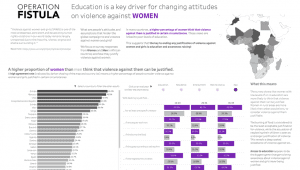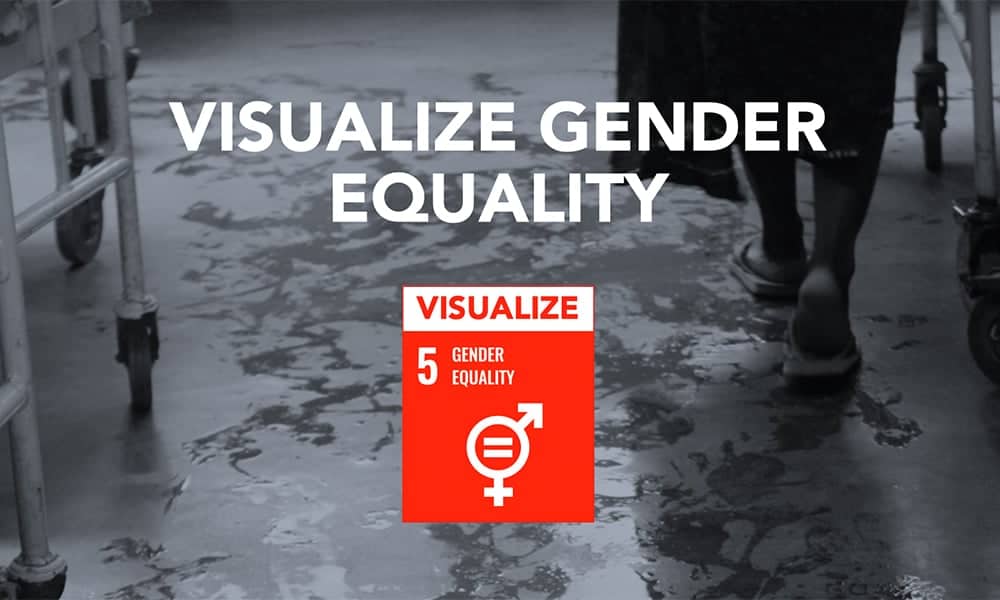Blog snapshot
This post will show you:
- What the Visualize Gender Equality project is
- The first set of global insights
- How you can get involved
Yesterday, Exasol’s partner Operation Fistula, #MakeoverMonday, and Tableau Foundation launched a hugely important project, Visualize Gender Equality.
The goal of Visualize Gender Equality is to use the power of Loading...data visualization to both raise awareness of extreme gender inequality and catalyze global action to end it. The project is known as “Viz5” because of its direct connection to UN Sustainable Development Goal 5: “Achieve gender equality and empower all women and girls.”
Viz5 went live on International Women’s Day. This day celebrates the social, economic, cultural, and political achievements of women everywhere and is intended to serve as a call to action for accelerating gender equality. For the Viz5 team, there seemed no better day to launch this collective effort!
What’s happening?
Yesterday, the team shared the first of the 12 data sets that will be published over the next 12 months. As I mentioned in my blog in February, the #MakeoverMonday community, spearheaded by Exasol’s Eva Murray, is hosting the initiative, and its participants will contribute to creating data visualizations for 12 different data sets over the course of the year.
The theme of the data that was published for the Viz5 launch is linked to UN SDG target 5.2: “End all violence against and exploitation of women and girls.” The data that was shared explores some of the attitudes and assumptions that hinder progress towards this target. Taken from a survey of men and women in African, Asian, and South American countries, the data explores the attitudes and perceived justifications given for committing acts of violence against women.
“When I saw the data that we would be using for the launch I was once again struck by the powerful mission of this project. In Viz5, #MakeoverMonday participants will be telling data stories and building visualizations that have the power to raise awareness, magnify advocacy efforts, and spark action to end some of the worst injustices that affect women and girls globally.” – Eva Murray
What we discovered
The types of abuse that women and girls around the world face include: rape and sexual abuse, forced marriage, human trafficking, femicide, domestic abuse, female genital mutilation, and other extreme forms of violence.
This is horrific, but tragically in areas where violence against women and girls is commonplace, such violent actions are seen as normal and justified responses to certain behaviors.
The data Viz5 shared yesterday reveals some shocking and disturbing insights into attitudes towards violence against women. For example, it shows that in the majority of countries surveyed, a higher percentage of women than men express that violence against them could be justified in certain circumstances. In every category of justification given for violence against them – including things as menial as the burning of food, or going out of the house without the husband’s permission – women are shown to be more likely to accept that there are valid justifications.

The data also exposes the influence that certain demographic and contextual factors have on the prevalence of these attitudes. We can see that if a woman lives in a rural area, and has received either a very basic level of education or none at all, then she is much more likely to express the attitude that violence committed against her can be justified or excused. This tells us that education level and environment are both deeply connected to the perpetuation of these attitudes to violence against women and girls.
“This data is hugely relevant to Operation Fistula’s mission. Women with fistula live in places where the spectrum of everyday injustice they face is profound. The majority of women living with fistula are from rural areas, and have little to no access to education. They experience extreme ostracism and abuse, and are often targeted, becoming victims of violence and cruelty because of their condition.” – Seth Cochran, Founder & CEO, Operation Fistula
What can we learn from the data?
Violence against women and girls is always an unjust and unacceptable violation of human rights. What we take from this data is that efforts to raise awareness, and extend access to education for women and girls are both critically important interventions in the work to ensure that no woman or girl has to endure acts of violence against them, under any circumstances, ever again.
Data like this provides deep insight into the complex range of challenges that must be addressed if we are to achieve gender equality. It also exhibits the interconnectedness of the injustices that women and girls face every day. This data on attitudes to violence against them reveals additional layers of injustice across a spectrum of areas, from human rights, to economic opportunity, access to education, and more.
What’s next?
This data, and the visualizations that are produced for Viz5 via #MakeoverMonday and the Tableau community, mean that we can both raise awareness and spur advocacy efforts to end violence against women and girls, everywhere.
Our Viz5 launch is just the beginning. The data stories and visualizations produced as part of Viz5 will not only begin to tell the stories of the women and girls behind the data, but also magnify the impact of advocacy organizations working to achieve SDG 5, and build an equal future for every woman, everywhere.
Join us, as we work to visualize a more equal world!
Keep watch for updates on the project by following @OpFistula, @TriMyData, @sethcochran, and #Viz5. If you want to become part of the viz5 community, sign-up at viz5.org!
By Helen Davies, Chief of Staff, Operation Fistula
